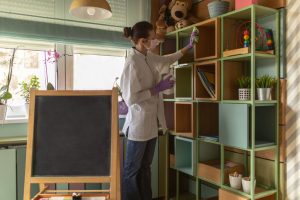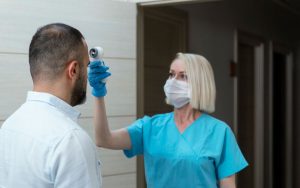6 Ways Psychology Professionals Can Protect Themselves and Their Patients When Social Distancing Restrictions Are Finally Relaxed

There has been a lot of buzz in psychology circles about the sudden shift that the field has made to offer services remotely. COVID-19 and the strict social distancing requirements that followed might have been what kickstarted the trend, but there’s good reason to believe that telehealth will be a very normal way to provide psychological services long after the pandemic is behind us.
Uncertainty and anxiety over COVID-19, along with official recommendations coming from public health officials, will almost certainly keep people from jumping immediately back into the old patterns of personal engagement.
In fact, psychologists are expected to see a lot of new clients due to those anxieties… social workers will see a huge spike in cases due to mass unemployment – more than could reasonably be handled with face-to-face meetings alone… while recurring waves of infection may turn lockdowns into a kind of revolving door, during which going fully online might simply seem like the easiest option.
It all comes together to point to a future where offering more services remotely goes from being a possibility to being very likely. But there are still plenty of reasons to think that in-person visits will always be something people prefer and insist on after COVID-19 is done making the rounds.
Remote Psychology and Social Services Aren’t For Everyone
Whether you’re a practicing psychologist or a student of psychology, you are probably fumbling around right now trying to get your own remote setup figured out. It hasn’t been all that easy, right? You have to carve out a place in your home where you can offer a private virtual space for yourself and for clients. You have to figure out how to keep your own home life from inadvertently intruding into sessions. If a work-from-home banker has their five-year-old accidentally stumble into a meeting about loan allocations, it’s cute; if it happens to a psychologist counseling a frontline medical worker or COVID-19 survivor, it could be pretty embarrassing for everyone.
There are some entirely reasonable concerns about the possible sticking points you could encounter when it comes to effectively providing remote counseling sessions – everything from privacy and anonymity when discussing personal matters, to basic information security and the reliability of videoconferencing technology, to the ability to adequately convey active listening and empathy through the camera.
For those reasons and others, psychology professionals are not going to go all-in on telehealth all the time after social distancing goes away. There are always going to be clients who prefer your couch to theirs; many counselors will find that they are always more effective in person than on a tiny video screen and weak laptop speakers.
COVID-19 isn’t going to disappear overnight, but it is going to fade into the background eventually, though that could take years. When social distancing and stay-at-home orders are finally relaxed, protective measures will need to continue for a very long time to deal with both the very real and perceived threats of COVID-19.
That’s why we’ve put together some actionable steps you can take to protect those patients, yourself, and your staff once in-person counseling visits become possible again.
1 – Get All Your Clients’ Concerns About COVID-19 Out in the Open

Until and unless a vaccine is developed, both clients and staff will be rightly nervous about any situation that involves mingling with strangers. It’s best to get those concerns out on the table right away, since leaving them undiscussed could cause those anxieties to fester and will only contribute to roadblocks in communication at exactly the time clients should be feeling at ease and opening up.
Some of those worries may be rational, while others may simply be from misinformation or misplaced fear. But in any case, hearing patients voice their worries about COVID-19 infection may also serve to reveal some insights into their mental state overall, while opening up other avenues of psychological concern to explore.
Talking about these kinds of immediate concerns right away allows you an opportunity to show something of yourself too, giving you a chance to reassure patients that you are thoughtfully taking steps to address infection control concerns because you genuinely care about your patients and staff. It shows you are taking the situation seriously, and taking evidence-based steps to help protect everyone around you as part of your duty of care.
2 - Consider Screening Patients on Arrival

Just a couple months ago, if someone suggested you put patients through a disease screening as soon as they set foot in your lobby, you’d probably laugh at the absurdity and impracticality of it all… but flash forward a handful of weeks and fixed temperature scanners on tripods are already a common sight in the U.S. and around the world, popping up everywhere, from government buildings to the lobbies of corporate offices.
This not only provides patients with some visual reassurance, setting your office up so you’re able to perform an elementary screening for anyone who comes in the door is actually now seen as a very practical and effective way to keep everyone safe, even those who don’t pass the screen.
And a screening doesn’t have to be a highly involved process or one that requires expensive hardware in the form of a stationary, tripod-mounted temperature scanner. It can be as simple as asking a quick set of questions about whether they’ve experienced any known COVID-19 symptoms recently or using a hand-held temperature scanner to get a quick temperature reading.
Although you’ll hate to turn people away if they don’t pass that screen, it shows you care enough to make sure your office is a safe place for everyone inside. And keep in mind, you’re even doing a service for those you turn away by letting them know they need to take steps to ensure their wellness.
Naturally, you should have information available to refer those who fail the screen to appropriate healthcare facilities or tell them what their next steps should be based on the the latest medical advice. Remember, it’s going to be pretty rare that even the people who don’t pass your rudimentary screening are going to end up testing positive for COVID-19. But you can’t take chances.
3 - Offer Options to Go Along with In-Person Visits

You’ll probably find many clients trapped in a sort of gray area: unhappy with remote services, but frightened to come in for in-person visits.
You should try to configure your practice to accommodate both options, and allow patients to move back and forth between them depending on how they are feeling each week, and as the situation develops on the ground.
Keep in mind that it’s all but a forgone conclusion that there will be one or more waves of COVID-19 that could subsequently result in rolling stay-at-home orders. As the pandemic ebbs and flows, it’s important for your practice to be as flexible as you’re asking your patients to be.
Some providers and patients are looking to alternatives to maintaining their appointment schedules entirely, electing instead to fall back on medications right now. And in light of the current situation, the DEA has relaxed requirements for in-person assessments for writing prescriptions to make it easier to do so. Although your professional opinion in some cases may have originally contraindicated psychopharmaceutical modalities, you may need to reassess what is practical under current circumstances.
This will cause you some additional administrative overhead, but it may offer patients the best set of options they can hope for at the moment.
4 - Reconfigure Your Office Space to Make Social Distancing Feel Natural

It’s engrained in all our minds at this point – from what we know currently, the virus that causes COVID-19 spreads primarily through airborne droplets spread when carriers cough, sneeze, or even just talk.
It’s equally engrained that the current CDC guidance is to maintain 6 feet of separation to avoid the spread of these droplets.
What you may not have considered, though, is that this distancing can be made a whole lot easier or harder depending on how your office is laid out.
Many healthcare facilities have reengineered their reception and treatment areas to allow people to more easily maintain this separation, or to put physical barriers between them when that’s impossible. Similarly, your therapy space may need to be adjusted to keep space between you and clients.
In reception areas, you may be able to put up clear barriers between patient areas and front office staff. In your therapy space, using plants and décor to form a small enclave can create a warm, inviting and comfortable environment for patients even when you’re halfway across the room. Try the same thing with nothing but empty space surrounding you and your client, and you’ll both end up feeling both exposed and a sense of isolation at the same time; something that’s definitely not going to help in creating a space conducive to open sharing and listening.
5 - Practice Basic Infection Control Steps and Clean Like You’re the One with OCD

To deal with lingering droplets, regular cleaning is recommended, and this should happen between every patient.
The CDC has published guidance on how to clean facilities, and it’s as basic as using soap and water where possible to clean surfaces. There is also a list of EPA-approved disinfectants for COVID-19 that can be used where water isn’t practical.
Infection control steps are even easier once you have a system in place. If you can restrict patient movement to clearly defined corridors and rooms, you can clean those spaces more often and more efficiently, without having to wipe down the entire office.
Another way to deal with controlling spread is by insisting both patients and staff follow the other basic infection control procedures that we should all be pretty familiar with by now, like wearing masks (as well as gloves and even eye protection for staff), and washing hands (on arrival for patients and between each visit for staff).
The CDC has comprehensive infection control guidance that is regularly updated based on the latest information available.
6 – Get Tested Yourself, and then Monitor for Symptoms On an Ongoing Basis

Finally, don’t forget about yourself and your staff as possible infection vectors.
Keep in mind that by opening back up for business, you can only ethically invite people into your space knowing that both you and your office staff are free and clear and not putting anybody else at risk.
Getting yourself and your staff tested should be considered a basic requirement for opening your practice back up.
And after that, the same procedures for screening that are used for clients at each appointment should apply to both you and your staff every day when you show up for work—temperature check and symptom screen.
Combine those daily screenings with generous sick time allowances and a strict policy about sending people home to self-isolate at the first hint of trouble. Even if you find yourself shorthanded for a couple weeks, it’s far better than risking lives.




